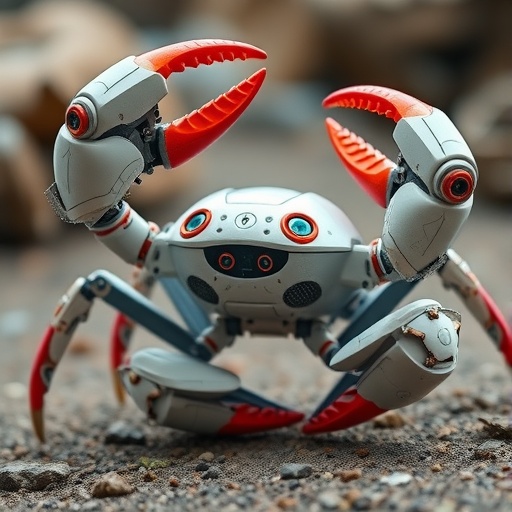In a groundbreaking exploration into the nuanced world of animal communication, researchers have turned to biomimetic robotics to unravel the complexities of sexual signaling among male fiddler crabs. These crustaceans, remarkable for their highly asymmetrical claws, engage in an elaborate ritual where the males prominently wave their enlarged claw outside their burrows to entice potential mates. The intriguing question driving this investigation was how these male crabs adjust their signaling behavior in response to the presence and actions of rival competitors in their immediate environment.
To probe this, scientists engineered a sophisticated robotic replica of a male fiddler crab, affectionately named “Wavy Dave,” capable of mimicking the characteristic claw-waving behavior with high fidelity. The setting for these experiments was a bustling mudflat in southern Portugal, home to thousands of these crabs, providing a naturalistic and dynamic backdrop for studying intraspecific communication. Wavy Dave was positioned approximately 30 centimeters from the burrow entrances of live males, equipped with two cameras to capture intricate behavioral responses elicited by this mechanical rival.
The findings revealed a fascinating layer of behavioral plasticity; real male fiddler crabs increased the duration of their claw-waving displays when Wavy Dave was actively waving, signifying a heightened investment in sexual signaling triggered by the perceived presence of a competitor. Intriguingly, while the duration of waving was prolonged, the crabs did not escalate the speed of their waving, suggesting a strategic modulation rather than indiscriminate amplification of their signal output. This implies that male fiddler crabs may interpret the waving of rivals as indicative of female proximity, prompting extended signaling but a cautious approach pending direct female presence.
.adsslot_7V6srdbHlY{ width:728px !important; height:90px !important; }
@media (max-width:1199px) { .adsslot_7V6srdbHlY{ width:468px !important; height:60px !important; } }
@media (max-width:767px) { .adsslot_7V6srdbHlY{ width:320px !important; height:50px !important; } }
ADVERTISEMENT
Moreover, the relative size of the robot’s claw played a crucial role in shaping male responses. Crabs exhibited a tendency to withdraw or reduce competitive displays when faced with a robotic rival bearing a larger claw, likely perceiving such a display as an intimidating signal of dominance and potential physical threat. This behavior aligns with evolutionary theories where physical traits such as claw size serve as honest indicators of fighting ability or quality, influencing the cost-benefit calculus of engaging in aggressive contests.
The robotic intruder, however, did not go unnoticed or unchallenged by some of the resident male crabs. Several individuals exhibited overt aggression, attempting to physically confront and incapacitate Wavy Dave, culminating in one dramatic incident where a male crab succeeded in dislodging the robot’s claw. This episode underscores the robot’s effectiveness in eliciting naturalistic interactions and validates its utility as an experimental tool in ethological studies.
The study, led by the Centre for Research in Animal Behaviour (CRAB) at the University of Exeter, and funded by the Natural Environment Research Council, is a pioneering step toward quantifying the dynamic interplay between sexual signaling and social competition in an invertebrate species. Such findings contribute critical insights into understanding how animals negotiate the costs of signaling and the influence of social context in shaping evolutionary pressures on communication strategies.
Beyond mere curiosity, these results carry broader implications for the study of animal behavior, signaling theory, and the evolutionary arms race prevalent in sexual selection. The plasticity observed in fiddler crabs’ signaling tactics illustrates a refined balance between attracting mates and avoiding costly confrontations, a compromise dictated by environmental cues and competitor behavior. By leveraging biomimetic robots, researchers now possess a powerful paradigm for dissecting these relationships with unprecedented precision and ecological validity.
In the context of ethological research, deploying robotic models offers novel avenues to experimentally manipulate variables that would be otherwise confounded or impossible in natural settings. The capacity to control specific aspects of the signal—such as waving rate, claw size, and positioning—permits rigorous testing of hypotheses about signal function, honesty, and receiver psychology. The successful implementation of Wavy Dave heralds a new era where technology synergizes with biological inquiry to decode intricate social behaviors in the wild.
This work also establishes a compelling precedent for how remote and automated experimentation can mitigate challenges posed by fieldwork, including researcher bias, observer influence, and logistical constraints. By operationalizing robotic proxies, scientists can standardize stimuli presentation, increase replicability, and conduct longitudinal studies that track temporal fluctuations in animal behavior with minimal disturbance.
Ultimately, this research not only elucidates the flexible sexual signaling strategies adopted by male fiddler crabs but also exemplifies the transformative potential of integrating robotic technology into behavioral ecology. As the boundaries between disciplines blur, such innovative approaches promise to deepen our understanding of animal communication, competition, and the evolutionary mechanisms that govern these vital processes.
Subject of Research: Sexual signaling and competitive behavior in male fiddler crabs studied through biomimetic robotics.
Article Title: Biomimetic robots reveal flexible adjustment of sexual signalling in a wild invertebrate
News Publication Date: 5-Aug-2025
Web References:
Centre for Research in Animal Behaviour (CRAB) at the University of Exeter: https://www.exeter.ac.uk/research/groups/psychology/crab/
BioSS: https://www.bioss.ac.uk/
DOI Link: http://dx.doi.org/10.1098/rspb.2025.1570
References:
Proceedings of the Royal Society B Biological Sciences, “Biomimetic robots reveal flexible adjustment of sexual signalling in a wild invertebrate,” DOI: 10.1098/rspb.2025.1570
Image Credits: Joe Wilde
Keywords: Ethology, Crustaceans, Invertebrates, Animals
Tags: animal behavior studies in Portugalbehavioral plasticity in animal interactionsbiomimetic robotics in researchclaw-waving behavior in crabsengineering robotic replicas for researchinsights into crustacean mating ritualsintraspecific communication strategiesmale fiddler crab communicationnaturalistic observation of crabsrivalry effects on mating displaysrobotic mimicry of animal behaviorsexual signaling in crustaceans





